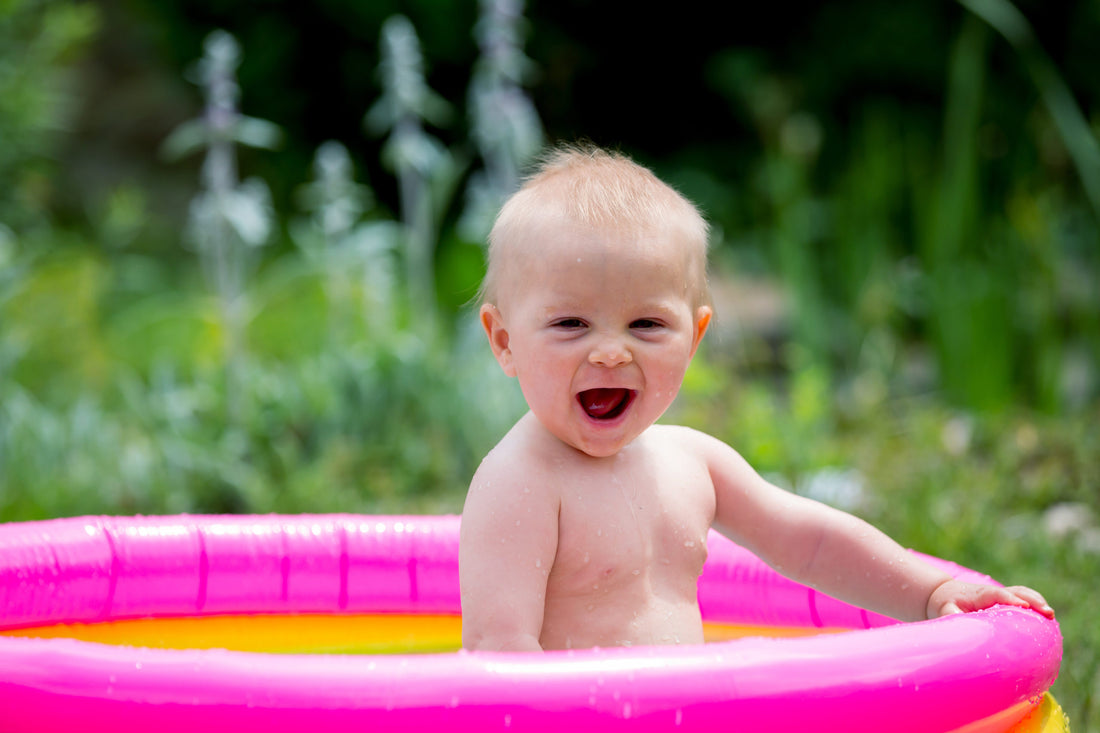
Summer Safety with Little Ones
Summer is upon us, and lots of fun in the sun awaits! It is tempting to spend all day outside in the fresh air and sunshine with your little ones, but you also want to keep them safe when you are outdoors in the heat. Here are some handy summer safety tips!
Disclaimer: this is not intended to serve as medical advice. Please contact your or your child's health provider with any medical questions or needs.
Hot Weather
When it is hot outside, it might seem like your little one needs to be drinking water, but for babies under six months, additional water is not recommended. Breast milk and formula provide all the water that your baby needs, even on a hot day. Breast milk is tailor-made for your baby, and your body will adjust to the weather. Formula guidelines are also set with this in mind, and the water baby gets from their formula feedings is enough.
Unlike young babies, it is important that toddlers get enough water when it is hot outside. Prolonged exposure to heat and direct sunlight can put young children at risk for dehydration. Make sure they are drinking and taking breaks in the shade or inside during their playtime. It is recommended that, daily, children drink the number of 8-ounce cups of water equal to their age. In hot weather or during an activity, children may want to drink extra water, and it is fine to give them more.
In terms of spending time in the sun, sunscreens are not recommended for infants under six months of age. The best way to protect an infant is to dress them in protective clothing and a wide-brim hat, and to keep them in the shade as much as possible. Once your baby is six months old, a sunscreen of at least 30 SPF is recommended - look for brands that are formulated for babies or for sensitive skin. Keep in mind when you're out in the sun that babies cannot cool themselves as well as adults and are at higher risk of overheating. If you are planning to be outdoors for long periods of time, an umbrella, a popup tent or a fan can provide additional cooling and shade.
Water Safety
Most babies love water, and watching them splash around is one of the joys of parenthood. Of course, water is also a hazard for little ones, so care should be taken when your baby is near any kind of water.
Some important things to keep in mind:
- Never allow an infant or child to play in or near water unsupervised.
- Never assume someone else is watching your child when they are in or near water. If you must leave, take your child with you or verbally confirm with a trusted adult that they need to supervise.
- Never dunk a baby or toddler's head underwater. While it is possible that they may hold their breath on instinct, they are likely to swallow water.
- Remember that age-appropriate swim lessons are great for your child, but keep in mind that lessons do not make your child "drown-proof."
- Always empty all tubs, buckets, containers and kiddie pools immediately after use. Store them upside down so they don’t collect water.
- If you are out on the water with your child, always have them wear a Coast Guard approved life vest that's correctly sized for their weight.
- Take an infant/child CPR class so that if something were to happen, you would be prepared.

Injuries
Cuts and Scrapes
If you can, have a first aid kit handy! You can keep a pouch with necessities in your purse or diaper bag.
Some things to include are:
- Bandaids, gauze and bandages
- Antibiotic ointment with pain relief
- Numbing spray (like Bactine)
- Baby wipes
- Tweezers
- Small scissors
- Alcohol wipes
Cuts and scrapes can often be treated at home, without a visit to the doctor. You can treat a cut or scrape at home by:
- Comforting your child and encouraging them to rest
- Rinsing with cool water
- Removing any dirt or debris from the wound; use small tweezers if needed
- Applying direct pressure to the area if there is any bleeding
- Treating with antibiotic ointment and a bandage
If the injury does not stop bleeding, take your child to their pediatrician or the ER
Bumps and Bruises
Bumps and bruises are common in small children; it goes along with exploring their world and learning how to navigate it. As a parent, though, it can be scary when your child falls or hits their head. Luckily, most injuries can be treated from home. Here are some things you can do.
If your child bumps their head:
- Have them sit down; offer comfort and make sure they rest
- Hold a cool cloth or wrapped ice pack on the sore spot; a bump may form on the place where they hit their head
- They may experience a mild headache, tummy ache or temporary dizziness
- If dizziness, nausea or headache persist, call the pediatrician for further advice
Call your pediatrician immediately if:
- Child experiences loss of consciousness
- Child falls asleep immediately and is difficult to wake up
- Child is severely nauseous or vomits
- Child has continued dizziness
- Child has trouble walking
- Injury will not stop bleeding
- Child cannot move head or neck or limb(s) in the same way as before
- Instead of a bump, an inward dent forms